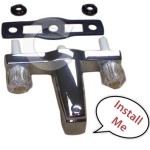The Essential Aspects of Bathtub Drain Linkage
The bathtub drain linkage is a crucial component that ensures proper water drainage and prevents leaks. Understanding its functioning and maintenance is essential for a seamless bathing experience. Here are key aspects of bathtub drain linkage:
1. Components and Mechanism
The bathtub drain linkage typically consists of several components: a stopper, a pivot rod, a lift rod, and a drainpipe. The stopper fits snugly into the drain opening to prevent water from flowing out. The pivot rod connects the stopper to the lift rod, while the lift rod extends through the overflow hole and allows you to open and close the stopper.
2. Operation
When you pull up the lift rod, it raises the pivot rod and leverages the stopper, causing it to lift and open the drain. When you release the lift rod, the stopper drops back into place, closing the drain and preventing water from escaping.
3. Common Problems
One common issue with bathtub drain linkage is a stuck stopper. This can be caused by mineral buildup, hair, or debris clogging the linkage. Other problems can include a broken pivot rod or lift rod, which prevents the stopper from operating correctly.
4. Troubleshooting
If your bathtub drain linkage is not functioning properly, there are a few troubleshooting steps you can take: Check for clogs by removing the stopper and cleaning any debris or hair from the linkage. If the pivot rod or lift rod is broken, you will need to replace them.
5. Maintenance
To maintain the proper functioning of your bathtub drain linkage, it is important to clean it regularly. Periodically remove the stopper and clean the linkage components with a mild detergent and brush. This helps prevent mineral buildup and clogging.
6. Professional Assistance
If you encounter persistent issues with your bathtub drain linkage, it is advisable to contact a professional plumber. They have the expertise to diagnose the problem and make necessary repairs or replacements to ensure optimal drainage.
Conclusion
Bathtub drain linkage is a crucial aspect of a functional bathroom. By understanding its components, operation, and maintenance requirements, you can prevent common problems and ensure a trouble-free bathing experience. Remember, proper cleaning and occasional inspection can significantly extend the lifespan of your bathtub drain linkage.

Central Brass Part Su 3359 A Bathtub Drain Linkage Assembly With Plug Guide And Rocker Arm Waste Overflow Kits Home Depot Pro

How To Replace Bathtub Drain Stopper With A Lift And Turn Diy

Drain Overflow Assemblies Fine Homebuilding

Danco Tub Drain Linkage Assembly 88924 The Home Depot

How To Fix A Bathtub Or Sink Pop Up Stopper Bathroom Drain

Kingston Brass Dtlr16 Trip Lever Bathtub Drain Linkage And Plunger For Dtl1161 Rough

How Can I Fix My Tub Drain Diy Bathtub Coil Ask Metafilter
:max_bytes(150000):strip_icc()/bathtub-drain-stopper-types-2718995-01-35b72b9323884e12bcd7bff7bddc755e.jpg?strip=all)
The 7 Common Types Of Bathtub Drain Stoppers

How To Adjust Bath Tub Drain Trip Lever

Everbilt 1 5 16 In Tub Drain Linkage Assembly Brass 865050 The Home Depot
Related Posts








